A Month with a Mac: A Die-Hard PC User's Perspective
by Anand Lal Shimpi on October 8, 2004 12:05 AM EST- Posted in
- Mac
Perfect Multi-tasking
So far, I've described OS X's multi-tasking as very similar to what is currently available under Windows, but where OS X sets itself apart is in a little feature called Exposé (note that typing an accented "e" is extremely easy under OS X - ALT-e followed by the "e" key or any vowel will do just that).By default, Exposé is activated by one of three function keys - F9, F10 or F11. Each function key serves a different purpose, each of which is a feature of Exposé. The theory behind Exposé is simple: it is a way of getting to a specific window on your desktop as fast as possible.
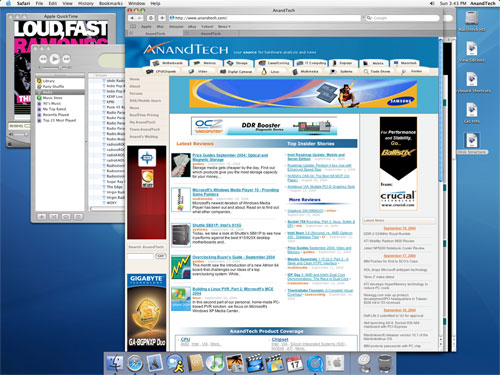
We start with our cluttered desktop...
Click to enlarge.
Hitting F9, for example, will cause Exposé to zoom out all of your active visible (unhidden) windows and essentially, tile them across your desktop. Then, using either the keyboard or the mouse, you can select the window that you want and everything goes back to normal, with the window that you have selected appearing in the foreground. The rest of the windows are untouched and are all in their original positions. The window that you selected is also in its original position; it is simply moved to the front so that you can see it.
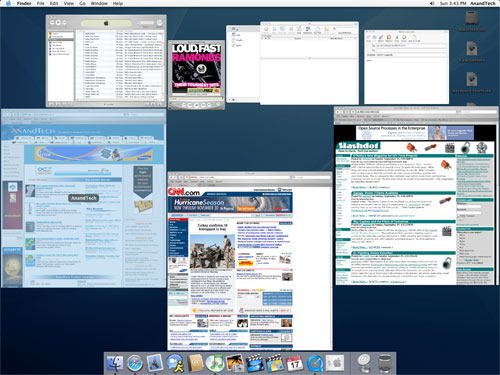
Hitting F9 activates Exposé across all applications.
Click to enlarge.
If you don't want to Exposé all windows, you can just Exposé the windows within a particular application (F10 by default), which is extremely handy for dealing with tons of images in Photoshop for example.
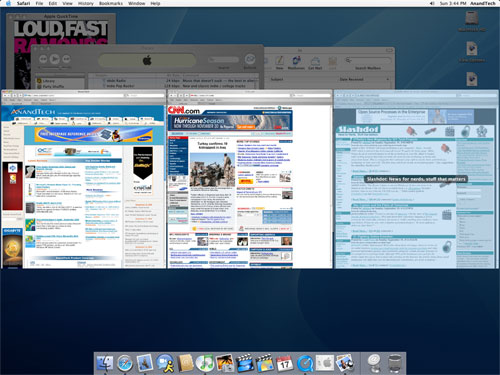
Hitting F10 activates Exposé across only a single application's windows.
Click to enlarge.
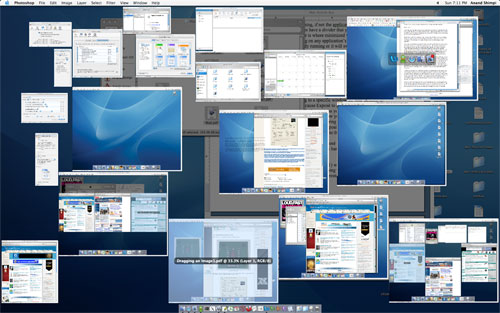
Another example of Exposé's usefulness in editing all of the images for this article in Photoshop.
Click to enlarge.
The final Exposé function lets you view your desktop (F11), which, to me, was like a more polished version of Windows-D, since after I was done doing whatever it is I needed to do on the desktop, Exposé deactivated and my screen was restored to its original state.
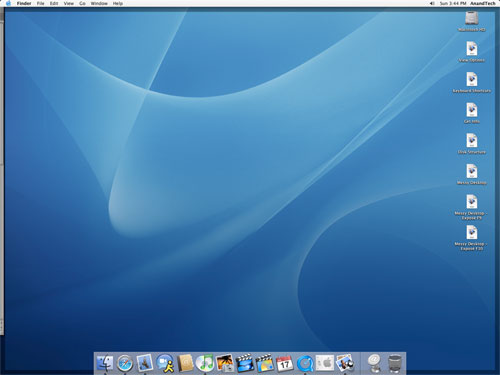
Hitting F11 reveals the desktop.
Click to enlarge.
The beauty of Exposé is difficult to convey in text alone. Honestly, the best way to evaluate it and understand its potential is to use it - luckily, there are Apple stores for this very purpose. Keep in mind that Exposé is very customizable as well and the three function keys that I mentioned above, although the defaults, are not the only ways that you can configure OS X to activate Exposé.
The benefits of Exposé are numerous. If you ever feel overwhelmed by having too many windows open, Exposé definitely alleviates that feeling as you don't have to tab through multiple applications to finally get to the window that you want. While Exposé does make having only a single display better, heavy multi-taskers will still enjoy the benefits of a dual display setup.
Since the OS X desktop environment is completely OpenGL accelerated, the performance of features like Exposé are not CPU limited - instead, they are GPU limited. Luckily, using Exposé with many windows open is not very stressful on even a Radeon 9600, but you do run out of video memory very quickly - in which case, your system ends up swapping to main memory over the AGP bus, making the Exposé animation considerably choppy. It seems that the sweet spot for more than a handful of windows open is around 128MB of video memory, with 256MB being perfect - needless to say, I found the mere 64MB that came on the Radeon 9600 which shipped with the system to be too little. There is no detriment to functionality if you don't have enough video memory; the Exposé animation simply becomes more choppy (which can be annoying on a $3000 system).










215 Comments
View All Comments
webchimp - Friday, October 8, 2004 - link
When you compared multitasking performance on a Mac to a Windows PC, was the Windows PC also a dual processor machine?One of the major benefits of multiple processors is multitasking performance and it would be unfair to compare a single processor PC to a multi processor PC regardless of the particular CPU and OS.
insomn - Friday, October 8, 2004 - link
"When writing an article (especially big NDA launches), I'd have around 20 IE windows open"IE?
www.getfirefox.com
20 IE windows = 1 firefox window.
CindyRodriguez - Friday, October 8, 2004 - link
I'll try to only comment on the big stuff.Anand doesn't get the application install process at all. He's overthinking it way too much. Things don't have to be 'windows complicated' in OS X.
In a drag and drop install, you aren't copying the "Application Installer" over to the hard drive. You're actually copying the Application its self over.
Applications in OS X are actually bundles. They appear as binaries but they are actually directories with a hidden .app suffix on them. Select any OS X native App and control-click or rightclick on it. A contextual menu will pop up, select "Show Package Contents". This is the whole application.
Contrary to what Mr. Shimpi said, there is no process were files are auto-magically copied to hidden and forbiden regions of your hard drive when you copy an application bundle from the installer disk to your hard drive. The application is entirely selfcontained so you are actually dragging everything over in one fell swoop. There is no disconnect because what you see in the install is what you get, a simple copy. OS X bundles are actually incredibly elegant ways to package applications.
Some applications do require some additional files to be installed into the OS and this is where Anand was getting confused. Not all application installs in OS X are simple drag-drops. Many use more familiar installer shells. Some Drag and Drop installs also contain self repairing, Office is one example. Though the install is simply a copy, the application does require some files (like fonts for example) to be installed into the OS. This occurs when the application is first run, not when you copy the application over. On subsequent launches, if any of the required support files have been removed, they are reinstalled in much the same way. This is also a very nice feature.
Chuckles - Friday, October 8, 2004 - link
With regard to your trouble opening folders and applications using the keyboard:Command-o opens whatever you have highlighted. I had never heard of Command-Shift-Down Arrow opening stuff before this.
CindyRodriguez - Friday, October 8, 2004 - link
Argh.. I could only get through the first two pages before I was ready to pull my hair out.* The article is outdated even though it was published today. Apple rev'ed that machine in July.
* G5s are expensive but so are similarly configured PCs. A dual opteron or dual Xeon from a real vendor with a real warranty will cost you just as much or more than the G5. I've actually spec'ed out dual G5s next to dual Xeons and dual Opterons and contrary to what Mr. Shimpi says.. do don't get "much more". Do it your self everyone.. but remember that a dual 2GHz isn't a $3K computer anymore.
* Your overview of the Mac on page 2 is wrong. Apple didn't ship a Radeon 9600. The rev one shipped with a Radeon 9600Pro. That may seem like picking nits.. but I bet you'd consider is significant if I offered you a free 9600Pro or a free 9600 but not both.
* Anand tells us in Page 2 to look at the specs to see how mediocre they are.. but he forgets to remind us that this computer is a Rev 1, not a rev 2.
* Anand apparently didn't bother to look at Apple's new DVI monitors. He asserts that you loose the cable clutter cutting benefits of ADC but this isn't true. There is STILL only one cable to the DVI monitor. The cable breaks out to power/usb/dvi at the computer end.. in fact, Apple's new cable now includes firewire.
* Once again, to pick nits.. the mouse cable on an apple mouse is short to plug into the keyboard not the monitor. Apple keyboards have always had pass through ports for the mouse.
I'll try to trudge through the rest when I get time.. but it's pretty painful so far.
knutp - Friday, October 8, 2004 - link
Sure there is a 2004 version of the Office pacage. Remember that this is a version only suited for Mac OS.http://store.apple.com/1-800-MY-APPLE/WebObjects/A...
KutterMax - Friday, October 8, 2004 - link
One aspect not touched on in the review is some of the other applications included with the G5, that being iMovie, iPhoto, and iDVD.I'm a PC user but my wife has her own G5. She does a lot of work with digital photography and video and uses these apps a ton. They seem to work really well and integrate nicely together. $3000 is a lot to justify for a machine, but certainly these apps add some value. Further, an iMac G5, which would be about half the price, would also include these same apps and provides a little more value for the money (but only a single processor).
ksherman - Friday, October 8, 2004 - link
the current version of the MS Office is 2003, not 2004... But a very god article indeed... Though i dont think ill be slapping down $3000 down for anything except a down payment on a car! :) I do agree that the slow downs that exist are crazy, given such an expensive computer. The fact that over 1GB memory is practically REQUIRED is a bit of an annoyance. But thats the price for a sexy OS!sgd2z - Friday, October 8, 2004 - link
ThatGuyPSU - Friday, October 8, 2004 - link
Thanks, Provia. I realized that after I hit Post Comment. Regardless, MS Office 2004 for the PC doesn't exist and probably won't since we're just about at the end of 2004. If anything, you'll see an MS Office 2005.